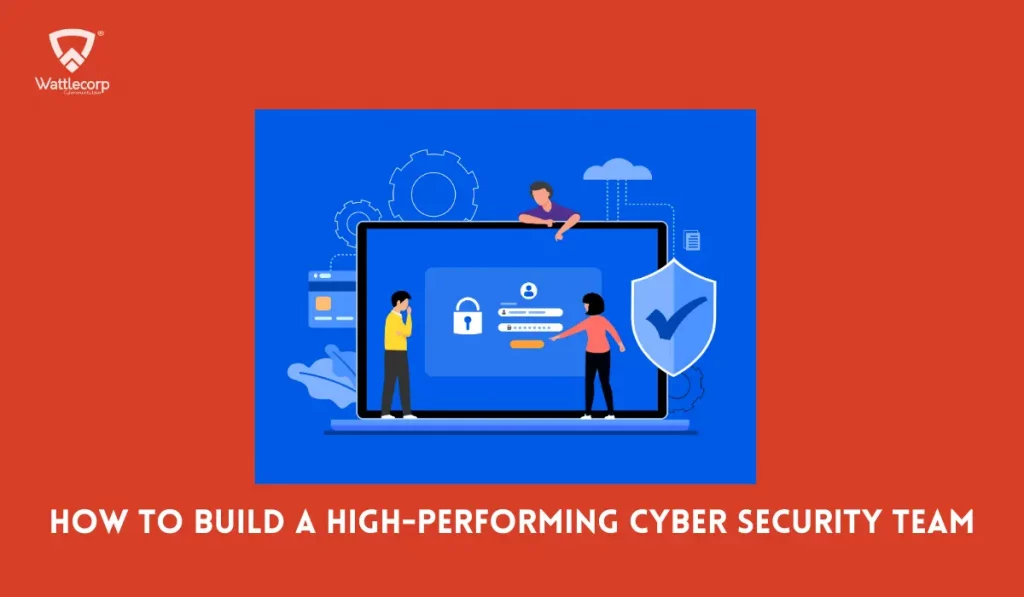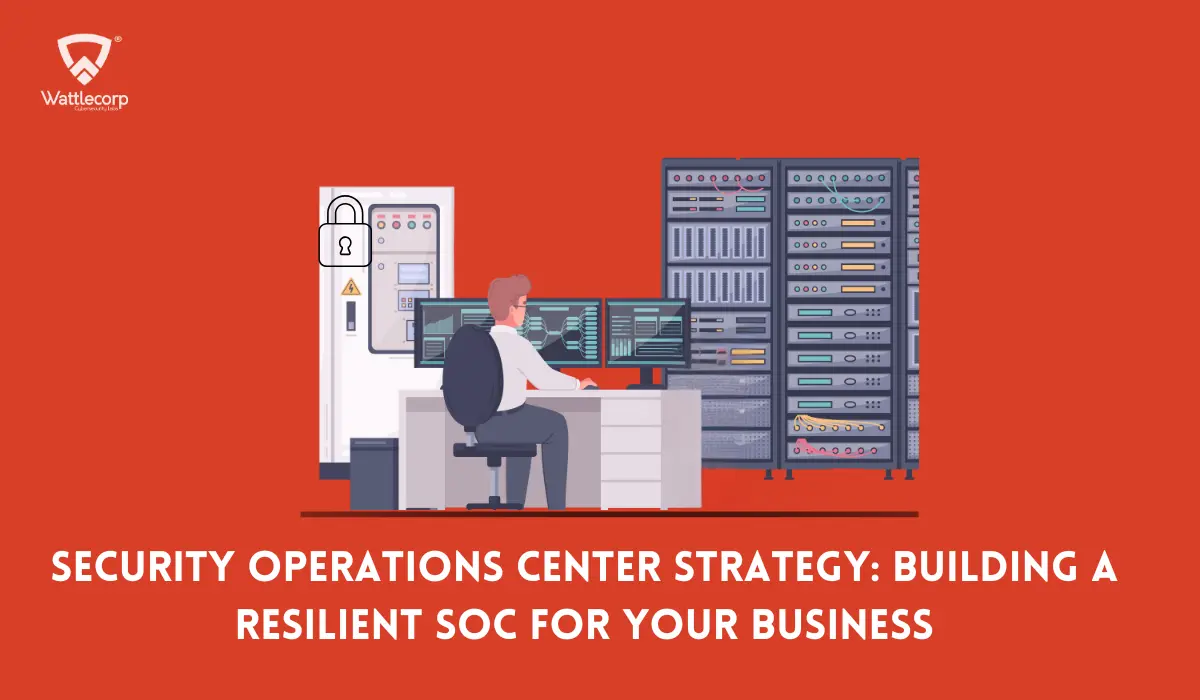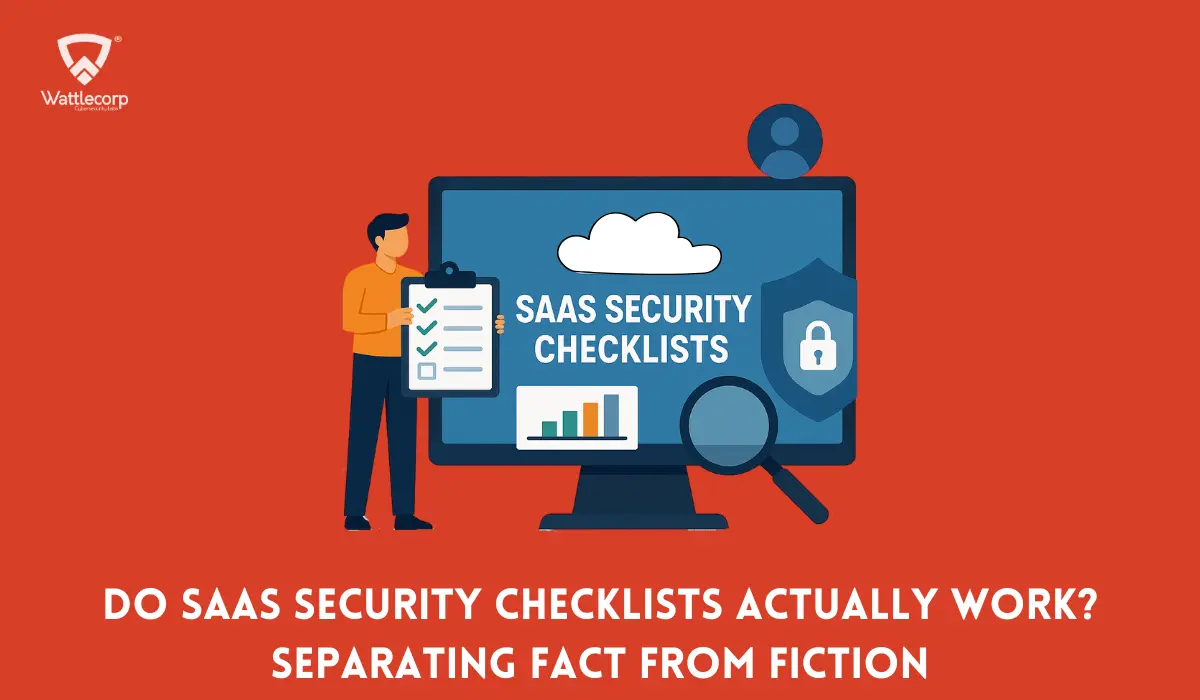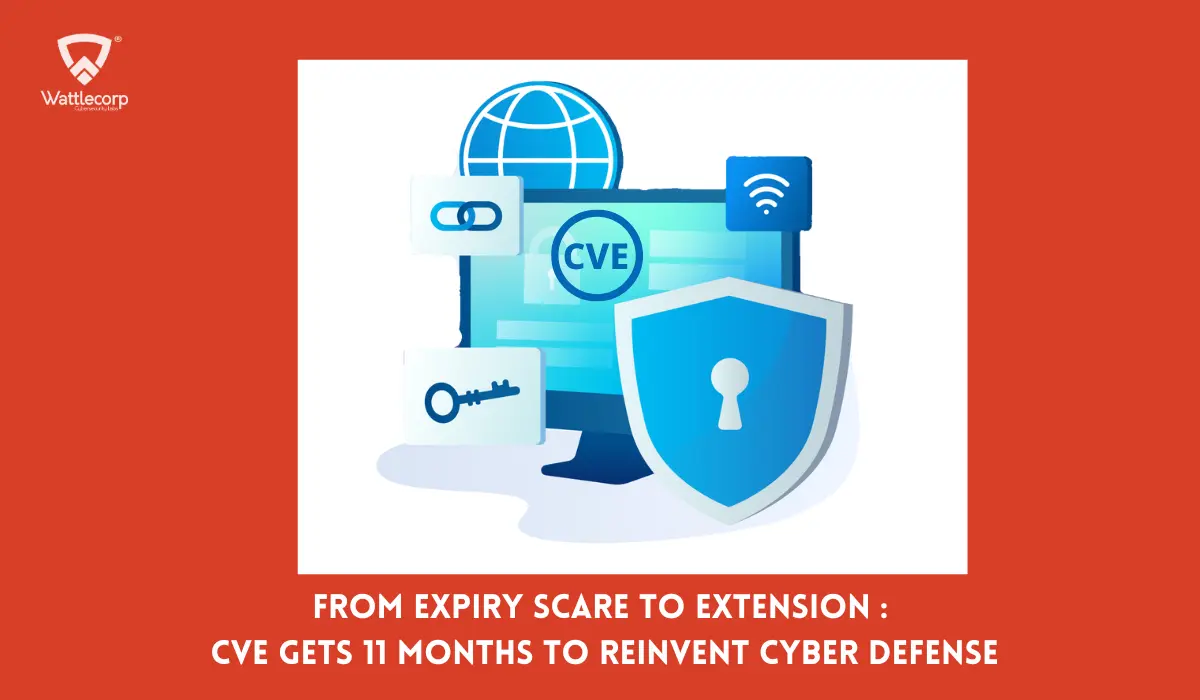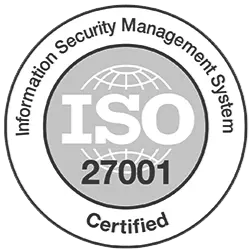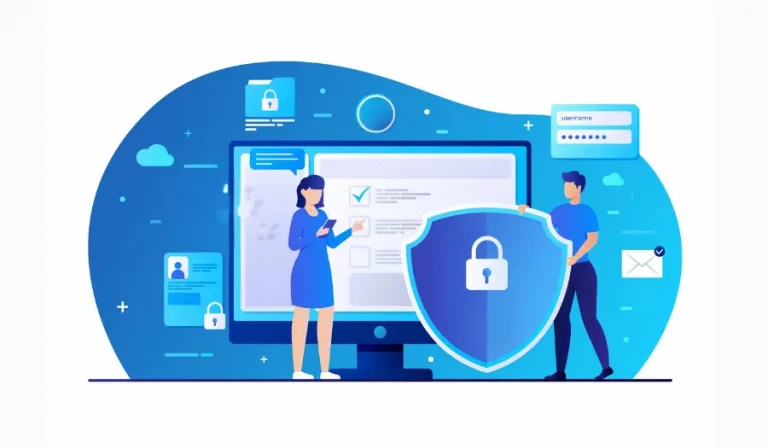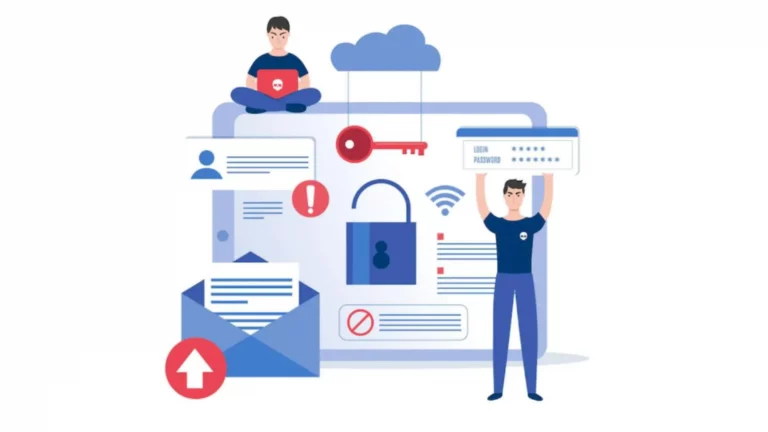Building a high-performing Cybersecurity team is a must for any modern SaaS company. With cyber threats escalating daily, you need a team that’s skilled, agile and proactive. Because they can help you defend against evolving threats, preserve business operations, and uphold customer trust.
This blog will help you understand the essential strategies for developing a high-performing cybersecurity team, offering insights into how we structure and empower our team at Wattlecorp to stay ahead of emerging risks.
Table of Contents
ToggleUnderstanding the Need for a Cybersecurity Team
The Rise of Cyber Threats
Businesses are more susceptible to cyberattacks as their reliance on technology grows. Data breaches, ransomware, and phishing schemes are just a few examples of the threats organizations face. A well-developed cybersecurity team is essential to protecting sensitive data and maintaining customers’ trust.
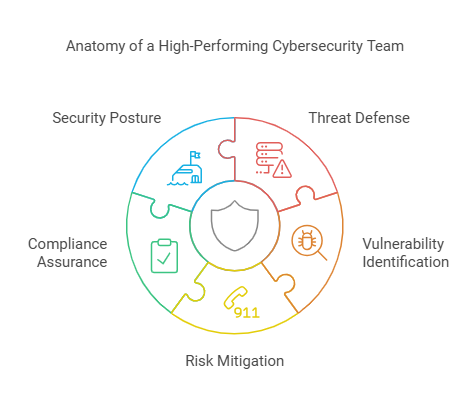
The Role of a High-Performing Cybersecurity Team
A high-performing cybersecurity team not only defends against threats but also proactively identifies vulnerabilities and implements measures to mitigate risks. This team serves as the backbone of an organization’s security posture, ensuring compliance with regulations and best practices.
Key Components of Cybersecurity Team Development
1. Define Clear Roles and Responsibilities
A strong cybersecurity team needs a clear structure where each member understands their role and how they contribute to the overall defense strategy. Clear roles and responsibilities help eliminate confusion, prevent task overlap, and ensure comprehensive coverage. Here’s a breakdown of common roles:
- Security Analysts
Monitor networks and systems for suspicious activities, conduct vulnerability assessments, and analyze data to identify potential threats.
- Incident Responders
Handle and manage security incidents, such as data breaches or system intrusions, to mitigate the damage, contain the threat, and ensure recovery.
- Compliance Officers
Ensure that the organization adheres to relevant security standards, regulations, and best practices (e.g., GDPR, HIPAA, PCI-DSS).
- Security Architects
Design and implement the overall security infrastructure, ensuring that systems and networks are built with security in mind from the ground up.
Each role is essential to maintaining a well-rounded cybersecurity defence, and having a clear division of labour helps the team execute coordinated responses when incidents occur.
2. Recruit the Right Talent
Building a successful cybersecurity team requires hiring individuals with a blend of technical expertise, critical thinking skills, and interpersonal capabilities. Here’s what to focus on during recruitment:
- Technical Proficiency
Candidates should be proficient in the tools, technologies, and protocols essential for defending against cyber threats (e.g., firewalls, intrusion detection systems, SIEM platforms).
- Problem-Solving Skills
Cybersecurity professionals often need to think on their feet and adapt quickly in high-pressure situations. Strong analytical and critical thinking abilities are essential.
- Communication Skills
Cybersecurity professionals must effectively communicate complex security issues to non-technical stakeholders, including executives, employees, and customers.
- Continuous Learner
Cybersecurity is an ever-evolving field. Seek out people who are interested in keeping up with the latest trends, vulnerabilities, and technology. Ongoing professional development (such as obtaining certifications) is a good indicator of this trait.
By looking for a combination of technical knowledge and soft skills, you ensure that your team can not only defend against threats but also collaborate across departments and continue learning in the face of new challenges.
So in short, to have a high-performing cybersecurity team within your organization, it is very important to prioritize candidates who showcase a balance of both technical expertise and problem-solving abilities.
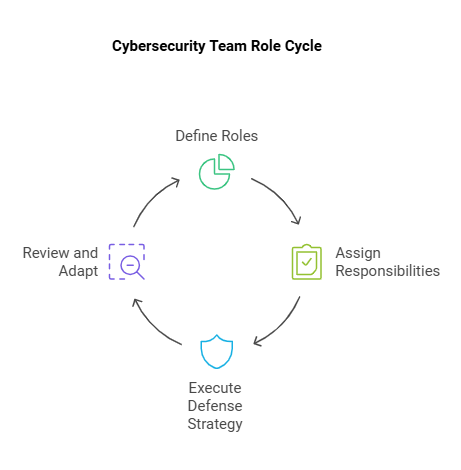
3. Foster a Collaborative Environment
Cybersecurity is a collaborative endeavour, not a one-man show. Both proactive threat avoidance and reactive incident response rely heavily on effective communication and information exchange. To form a cohesive team.
- Regular Meetings
Schedule routine check-ins and team meetings to discuss security concerns, share recent findings, and review ongoing tasks. This keeps the team focused on the same goals and encourages free communication.
- Cross-Functional Collaboration
Encourage collaboration between the security team and other departments like IT, compliance, and legal. This helps ensure that the security strategies align with broader business goals.
- Knowledge Sharing
Create platforms (e.g., internal wikis, Slack channels) where team members can share insights, articles, and findings related to security vulnerabilities and threats.
4. Implement Regular Training and Development
The cybersecurity landscape evolves rapidly, and ongoing training is critical for keeping your team prepared. Continuous development guarantees that your staff is well-equipped to face changing risks and technology. Here’s how you can approach training:
- Workshops & Seminars
Organize regular workshops to address new and emerging security threats. Bring in experts from the field to host seminars on the latest technologies or threat vectors (e.g., ransomware, phishing).
- Certifications
Encourage team members to pursue industry-recognized certifications to further their knowledge and skills. Popular certifications include:
CISSP (Certified Information Systems Security Professional)
CEH (Certified Ethical Hacker)
CISM (Certified Information Security Manager)
CompTIA Security+
- Simulated Attacks & Red Teaming
Use tabletop exercises or penetration testing to simulate real-world attacks. These drills allow your team to practice responding to incidents in a controlled, low-risk environment.
By fostering a culture of continuous learning, you ensure that your cybersecurity team is always ready to defend against new and evolving threats.
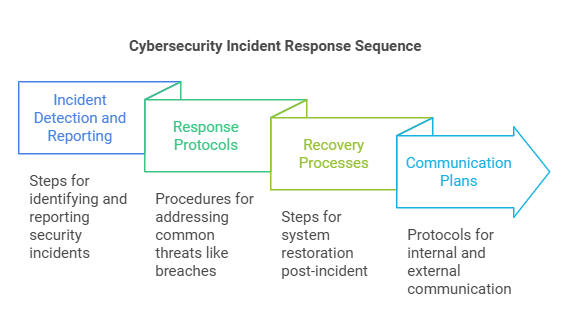
5. Establish Standard Operating Procedures (SOPs)
Having well-documented Standard Operating Procedures (SOPs) is essential for ensuring a fast, coordinated, and effective response to security incidents. SOPs provide clear guidelines that can be followed in the heat of an incident, minimizing confusion and reducing the risk of errors. Key SOPs should include:
- Incident Detection and Reporting
Define the steps for detecting and reporting potential security incidents. Include criteria for what defines a “security incident” and how it should be handled.
- Response Protocols
Develop detailed procedures for responding to common threats such as data breaches, malware infections, and denial-of-service attacks. Ensure these procedures are well understood and practiced by the team.
- Recovery Processes
After a security incident, your team needs to quickly recover and restore systems to normal operation. Define the steps for incident containment, forensic analysis, and system restoration.
- Communication Plans
Establish clear protocols for internal and external communication during incidents. This includes informing leadership, stakeholders, regulatory bodies, and possibly customers, depending on the nature of the breach.
By establishing and enforcing SOPs, you ensure that your cybersecurity team can respond swiftly and effectively to threats, minimizing the damage and downtime associated with security incidents.
6. Promote a Security-Centric Culture
One of the key factors in building a successful cybersecurity team is creating a security-first culture across the entire organization. Partnering with Managed Security Services in India can help reinforce this culture by providing expert guidance and resources tailored to your business needs. A strong cybersecurity culture involves:
- Training All Employees
Educate everyone in the organization (from top executives to entry-level employees) on basic cybersecurity hygiene, such as using strong passwords, recognizing phishing attempts, and avoiding risky online behavior.
- Fostering Ownership of Security
Encourage employees to see themselves as part of the cybersecurity defense strategy. Empower them to report suspicious activity and follow best practices for data security.
- Leadership Support
Ensure that senior leadership advocates for and supports cybersecurity efforts, both financially and culturally.
Creating a culture of security across the organization helps ensure that everyone plays a part in protecting against threats, not just the cybersecurity team.
Also Read: Top 15 Cybersecurity Frameworks in 2024
Best Practices for Cybersecurity Team Development
1. Emphasize a Risk Management Approach
A proactive risk management approach is essential for a high-performing cybersecurity team. This involves:
- Regularly assessing potential risks
- Prioritizing threats based on impact and likelihood
- Implementing appropriate controls to mitigate identified risks
By focusing on risk management, your team can allocate resources effectively and enhance overall security.
2. Leverage Automation and Tools
Utilizing cybersecurity tools and automation can significantly enhance your team’s efficiency. Implement solutions for:
- Threat detection and response
- Log analysis
- Vulnerability management
Also Read: Large Language Model (LLM) Security: Risks, Checklists & Best Practices
Automation relieves team members of the load of repetitive duties, allowing them to focus on important responsibilities.
3. Monitor and Measure Performance
To ensure continuous improvement, it’s vital to monitor the performance of your cybersecurity team. Establish key performance indicators (KPIs) such as:
- Time to detect and respond to incidents
- Number of incidents handled per month
- Percentage of successful security training completions
Regularly reviewing these metrics will help identify areas for improvement and recognize team successes.
4. Encourage a Security-First Mindset
It is critical to foster a security-focused culture throughout the organization. Ensure that all employees understand their role in maintaining security, including:
- Training on recognizing phishing attempts
- Reporting suspicious activities
- Following security protocols
A unified approach to security makes your cybersecurity team’s efforts more effective and reinforces the importance of cybersecurity.
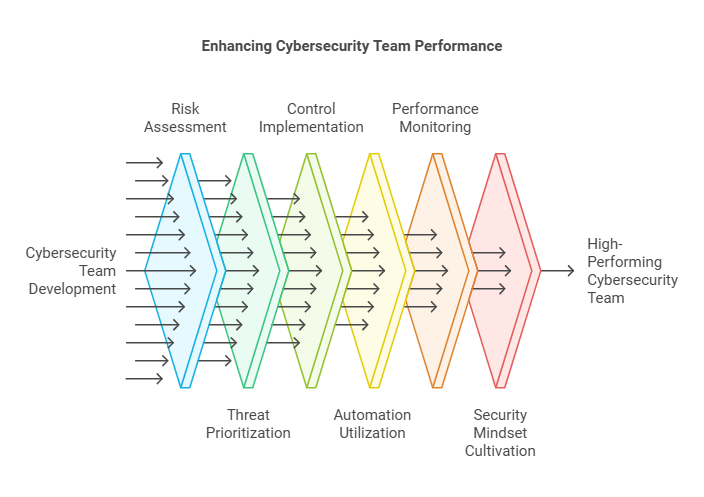
Steps for Building a High-Performing Cybersecurity Team
1.Assess Current Capabilities
Begin by evaluating your current cybersecurity capabilities. Identify gaps in skills, processes, and tools that need to be addressed.
2.Define Your Goals
Set clear, measurable goals for your cybersecurity team. This could include reducing response times, improving incident resolution rates, or achieving specific compliance standards.
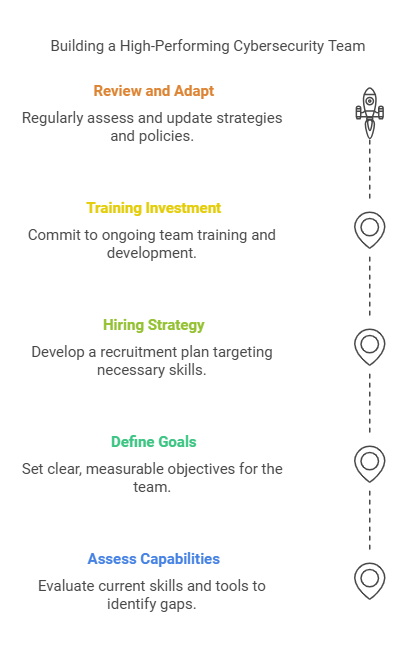
3.Build a Comprehensive Hiring Strategy
Develop a recruitment strategy that targets the skills and experiences needed for your team. Use job descriptions that reflect your organization’s unique needs and the competencies you seek.
4.Invest in Training and Development
Commit to ongoing training and development for your team members. This investment pays off by ensuring your team is equipped to handle evolving threats.
5.Regularly Review and Adapt
Cybersecurity is an ever-changing field. Regularly review your team’s performance, training needs, and the effectiveness of your security policies to adapt to new challenges.
Metrics for Measuring Cybersecurity Team Performance
Evaluating the Effectiveness of Your Cybersecurity Team
To ensure continuous improvement in cybersecurity team development, it is crucial to measure performance using relevant metrics. Key performance indicators (KPIs) may include:
- Incident Response Time
The average response time to security events.
- Number of Security Incidents
Tracking incidents over time can help gauge the effectiveness of your team’s efforts.
- Employee Training Completion Rates
Monitor participation in training programs to assess awareness levels across the organization.
Building a strong cybersecurity team is crucial to protecting your clients’ data. Here’s how to do it:
- Define clear roles so everyone knows their responsibilities.
- Hire the right talent to ensure your team has the skills needed to tackle threats.
- Encourage collaboration to improve problem-solving and efficiency.
- Invest in training to keep your team sharp and up to date on current dangers.
- Promote a security-first culture to make cybersecurity a shared priority across your organization.
This not only improves your defence but also builds a more proactive and resilient approach to cybersecurity.
High-Performing Cybersecurity Team FAQs
1.What are the essential skills needed for a high-performing cybersecurity team?
A high-performing cybersecurity team should possess a mix of technical skills (such as network security, threat analysis, and incident response), analytical abilities to interpret complex data, and soft skills like communication and teamwork. Because cybersecurity threats evolve so quickly, continuous learning is also critical.
2.How can I assess the effectiveness of my cybersecurity team?
You can evaluate your cybersecurity team’s effectiveness by tracking key performance indicators (KPIs) such as incident response time, the number of security incidents over time, and employee training completion rates. Regular performance reviews and feedback sessions can also provide insights into areas for improvement.
3.What role does continuous training play in cybersecurity team development?
Continuous training is vital for keeping your cybersecurity team updated on the latest threats, tools, and best practices. Regular training ensures team members can respond effectively to new challenges and helps foster a culture of learning and adaptability within the organization
